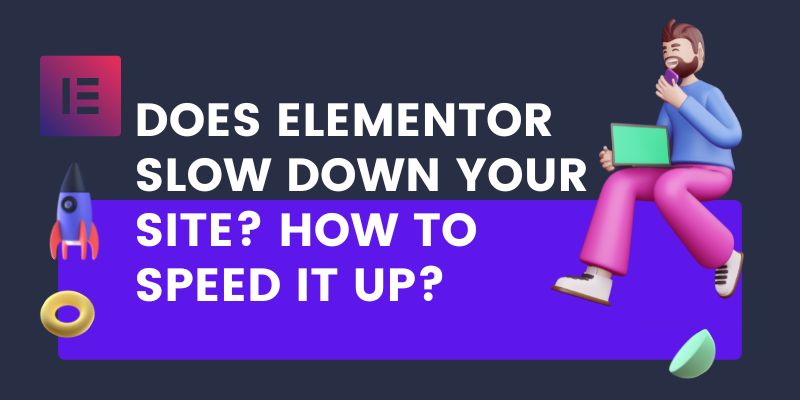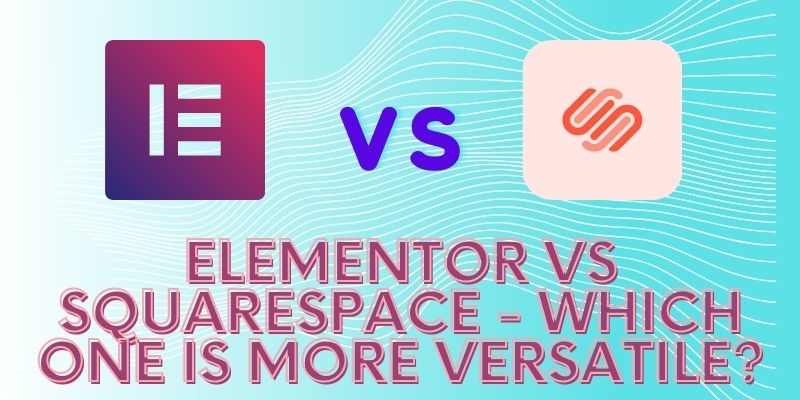Does Elementor Slow Down Your Site? How to Speed It Up?
We all enjoy WordPress because of its wide range of plugins. However, like any third-party add-ons have certain negatives.
Elementor is one of the more well-known plugins, is known as slowing certain websites. Do you believe it? Is Elementor cause slowdowns on your website?
It’s a truth, but there’s an exception. While Elementor is a heavy-duty product and efficient, it’s also quite effective. The majority of Elementor websites are slow due to external factors like poorly optimized third-party code or excessive plugins.
However, you don’t have to eliminate Elementor or require a slow website. Learn more about the most efficient ways to improve your WordPress website now.
Does Elementor Make Your Website Slower?

Elementor is not a slowing factor down a site. Being one of the most well-known and widely downloaded plugins, its developers have optimized every inch and crevice within their program.
An Elementor website can slow down because of a variety of common problems. Understanding the causes in advance will help you determine the areas you must improve.
Cheap shared hosting
First, the slowest Elementor websites are hosted on shared hosting. It’s a slow-running hosting system that makes use of only one server to run various types of websites. Sharing resources doesn’t work in the case of websites, which is why it’s not a surprise that some sites are slow.
Modules and plug-ins for Bloat
When creating a website, the majority of people utilize a lot of plugins, but they do not recognize them. Every developer has to go by trial-and-error to discover the best plugin. But , the process can leave an abundance of unneeded modules and plugins, which consume resource and may slow websites.
Backend is not optimized
The backend can be used for creating customized HTML and third-party codes, custom graphics and fonts, etc. While the backend is crucial for every website, many developers fail to optimize it once they have implemented it. Optimized fonts and images as well the code of third parties creates inadequate backend performance that results in a website becoming extremely slow.
There you go These are the primary reasons for your Elementor website to be slow. If you can, visit your WordPress dashboard right now and attempt to resolve the issues that you are aware of. If you want to learn how to improve other aspects of your website read on.
How do you speed up the speed of a slow Elementor website?
With a few modifications With a few adjustments, the Page speed on Elementor will dramatically improve within a matter of minutes. First, let’s go through the most popularand technology-savvy method for doing this.
What’s Lazy Load Elementor?
Lazy loading is the process which means that website resources such as fonts or images are displayed only when they are required in contrast to large-scale loading, where the entire website is loaded first. lazy loading is more efficient and helps save resources. An example that lazy loading can be seen is the endless scrolling we can observe when we browse YouTube, Twitter or any social media.
It sounds great, isn’t it? You can add lazy loading into Elementor using the Optimole WordPress plugin.
Lazy loading can improve the performance of backends even when backend components are optimized inherently. Let’s improve them.
-
Optimizing Backend Media
If your site fails the speed test for your website the backend may not be optimized. elements such as videos, images, gifs, files, as well as other media that is responsible for. Since you’ve disabled lazy loading, the issue is likely to be reduced. The next tweaks will dramatically improve the speed of your application.
-
Change Image Dimensions
Begin by resizing the media files as small as you can while maintaining the clarity of your files and their resolution. Several online websites allow you to do so. This type of image processing reduces the size of images and consume less resources. The less resources you use will be used, the more efficient your website will load.
-
handles video files
The next step is to fix the video media. Maintain the frame rate low. 30 or 23 frames per second is perfectly. In terms of resolution, make it as low as feasible when you’re using it for the main page.
If you wish to show a larger-sized video then we suggest placing it onto a different page to show it in maximum resolution. This will allow you to efficiently share the resources available.
-
Find Better Hosts
It’s time to get rid of low-cost shared hosting plans when you’re planning to go serious about the development of your WordPress websites. While they’re inexpensive and free, they’re ideal for only personal projects like blog articles.
You must get high-end hosting in order to provide the best user experience possible for the most serious sites.
You should choose hosting solutions that are natively compatible with perfectly with Elementor. For premium hosting plans that are great we suggest nestify, Bluehost and WP-Engine..
-
Inspect and Modify Third-Party Code
For custom-made Raw HTML and JS code, make sure you know whether the developer made sure to keep WordPress optimization in the back of his/her mind. If it wasn’t, then you’re better off not using the code. You can try removing the code completely as much as you can.
However, if you feel it’s important to your website Try two strategies:
- Minimize Raw CodeIn minification, the aim is to reduce the size of the script file. This can be achieved by removing spaces from the script and changing tabs to spaces.
- Concentrate Code files: It involves combining several related category file files to create one. It’s a great practice in programming to use distinct files for each task. To be successful with the page speed examiners for WordPress it is recommended to combine all code scripts similar to one. This will reduce the size of your files and is vital to speed up performance.
It is best to first make these adjustments by hand. After that, you can seek assistance from plugins such as WP Rocket. Autoptimize, which we’ll speak about in the future is an excellent option too.
-
Discard Modules Like Google Fonts
External modules, such as custom Google fonts can be unoptimized for WordPress and can cause issues. For linkups such as YouTube, Facebook, Google Maps as well as Google Fonts, we recommend to eliminate them all together.
It’s not easy to make them more efficient on your own, however, even if you manage there are a few alternatives. We suggest using a WordPress-optimized WordPress plugin instead.
-
Eliminate Unnecessary Plugins
In the event that you examine a close glance at your dashboard, you’ll notice there are more plugins than what you require. However, they’re on the back burner, consuming resources. Now is the time to go through them and delete any you don’t require.
-
Data Optimization
A majority of people set up an automated database, only to put it aside later. But , often databases hold a great deal of invalid and useless information. If you allow it to grow out of control it will take up space.
The speed of queries is dependent on how big the database. It is therefore essential to keep the information you require and eliminate the rest. It is recommended to remove the inactive users, their data including junk comments and caches as well as other unneeded files from your database. There are a variety of filters for clearing spam as well as cache available on WordPress to make use of.
-
You might want to consider changing your WordPress Theme
Your WordPress theme may be the cause of slowing your website. Some themes do not work perfectly with Elementor and, as a result causes inexplicably slow loading times and lags.
Go to your WordPress theme’s site to determine whether it’s integrated with Elementor. If not, you should consider altering it. We suggest using Elementor’s default themes. Because they’re created by Elementor and have the greatest integration.
-
Allow Helpful plugins
After you have removed the plugins that you don’t require then you can install the ones that will really be useful. We suggest Autoptimize to do the job.
When you’ve completed your manual tweaks, Autoptimize can be an excellent way to automate tweakings to prepare for future media inserts. It removes caches and unneeded scripts, it makes lazy-loading automatic for images and much more. Autoptimize makes tweaks to optimize Google Fonts as well as other programs, too, but we wouldn’t suggest to rely on it too much.
In addition, CSS codes are added to make websites more efficient and smoother than it was prior to.
Pro Tips & Mistakes To Avoid

The subjects we’ve covered up to this point should suffice to boost the Elementor performance of your site significantly. Let’s review the must-haves and don’ts of running a bug-free and efficient website.
-
Continuously clears cache
Every week, once sufficient for most websites. Look on your WordPress dashboard for clearing options. If you are able, create a hotkey to clear it fast each time.
-
Utilize File Compression
Gzip compressions using extension .gz, .tar, or .tgz are among their most effective. Linux is the most efficient operating system, is also able to use these types of compression. To accomplish this make sure you create an .htaccess file to WordPress. It is also possible to search at WordPress Gzip compression software to do this task.
-
Keep Default Colors
Each theme comes with standard colors, and it is recommended to make use of these colors. The best theme will be optimized around the color family, which means that occasionally it can be slow when you alter the colors.
-
Continuously monitor website speed
Track how well your site’s speed is running regularly. Services such as PageSpeed Insights from Google and other services from outside can be a great method to track this. Create a spreadsheet , and make any necessary adjustments so that the speed of your website is within your control!
Conclusion
If you’ve been following us this to now, “Does Element slow down your website? ” It’s true that your WordPress site should be operating more efficiently than ever. It’s no longer necessary for Element to fall in the background, and we believe you’ll understand it soon.
For a final suggestion We recommend paying attention to Elementor’s blog. They publish regular blog posts on Element and ways to make the most of it. By following the advice and tricks they provide you will be able to further optimize the elements efficiently that is possible.
Best of luck and we’ll hope to see your name at the top of Google indexes!
More: Does Elementor Slow Down Your Site? How to Speed It Up?



